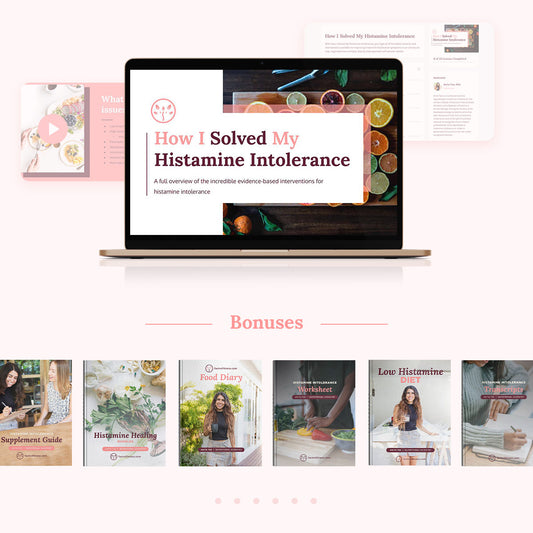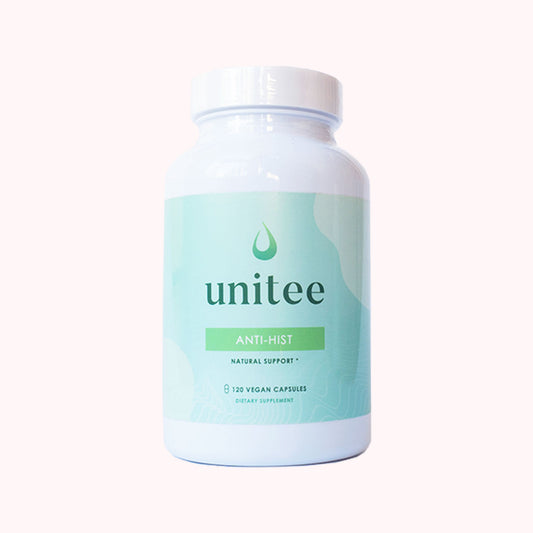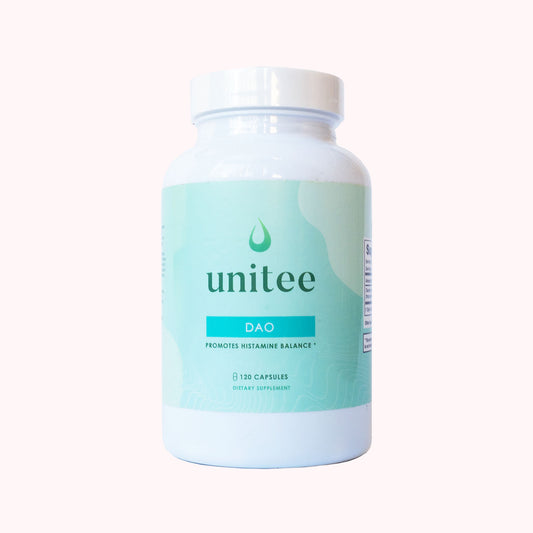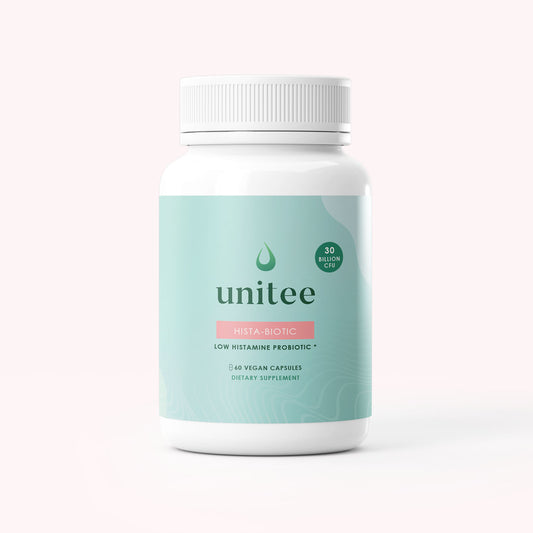If you’ve been with me for a while, you’ll know how much I like to focus on the root cause of diseases instead of simply addressing the symptoms.
Today, we’re going to stick with that theme and delve into another condition we’re seeing spring up in many of our histamine intolerant clients.
It’s a condition that’s on the rise in the general population, but has seldom been linked with histamine intolerance despite the complementary symptoms the two share.
Have you ever heard about SIBO?
Histamine Intolerance and SIBO: Symptoms
Headaches, hives, food intolerances, you name it. You’re already familiar with the typical histamine symptoms and I don’t have to go through those again with you.
But what about feeling so full you can’t bare to eat the first bite of your meal, even though you haven’t eaten for hours?
Or the gnawing, tugging sensation you have in the right lower portion of your abdomen, which may feel like there’s a little creature, twisting and turning on the inside?
Then there’s the unpredictable diarrhea you don’t understand why you’re having, or the constipation that leaves you feeling backed up for days; you can hardly eat, so what’s going on?
While digestive symptoms are common with histamine intolerance (1) and you’re probably getting used to being bloated all the time, these are a little different.
In fact, they’re typically associated with a problem that affects the small intestine instead of the large intestine, which we associate with histamine intolerance.
This condition is called small intestinal bacterial overgrowth, also known as SIBO.
SIBO: A Brief Overview
You’re likely well aware that there are trillions of bacteria and other microorganisms living in your large intestine, and you may think that it would be the same for the small intestine.
Well, this is not so.
Instead, the small intestine has fewer microorganisms, which are made up of different species compared to those you’ll typically find in the large intestine.
In SIBO, the cause of the symptoms are because the bacteria from the large intestine have moved up into the small intestine (2).
Now, the role of the bacteria in the large intestine is to ferment the products of food breakdown, preparing everything that has not been absorbed to be excreted as waste.
When these bacteria are performing this function in the small intestine where foods are meant to be absorbed, it causes trouble.
It leads to one of the telltale signs of uncomfortable upper digestive discomfort, where you feel like there is something pushing up against your stomach. Some describe it as a big air bubble they feel is stuck in their gut, and it leads to low appetite, and sometimes reflux and/or nausea, along with bloating, pressure or even pain across the abdomen.
That tugging I mentioned?
It’s associated with changes in the ileocecal valve that acts as a gate protecting the small intestinal contents from the large.
If this gate is no longer working, we have movement of the contents of the intestines in the wrong direction, which may result in the microorganisms spreading from their original position in the large intestine to the small intestine.
How does it affect histamine intolerance?
The SIBO and Histamine Intolerance Connection
Because the microorganisms are in the wrong place, the immune system responds.
Histamine carrying mast cells are activated and contribute to your histamine symptoms. Your food intolerances ramp up, and your ability to break foods down declines. It all compounds the histamine issue (3).
Addressing the root cause to tackle SIBO and thus your histamine intolerance starts with diet.
A 4 Step Approach to SIBO and Histamine Intolerance
1) The first step is to follow a reliable low histamine food plan. You don’t want to aggravate the symptoms by adding to your histamine load, so even though you’re still experiencing gut symptoms, it’s a great way to lessen the overall histamine ones. Click below to get the free Low Histamine Diet Guide, which includes a full foods list and extra info for maximizing the benefits of this diet.
Try to include as many of these foods into your diet to maintain some sort of diversity through the restriction. But take the next point into account when you do.
2) Step two is to take away the food that will typically feed the microorganisms in the small intestine. Fermentation of carbs, sugars and starches occurs quickly, and so eating a diet high in these types of foods may be contributing to your symptoms, especially when this fermentation takes place in the small intestine instead of the large.
A small amount of carbs such as ½ a cup of plain white rice a day and a serving or two of low glycemic index fruit such as low histamine berries is usually well tolerated, especially when eating them alongside a protein and/or fat containing meal that slows the movement of these quickly digesting components through the gut.
Remember to eat protein, lots of tolerated vegetables, and healthy fats (again, refer to the free histamine diet e-book above to guide you), to ensure you’re full and satisfied.
You may want to consider taking histamine-digesting enzymes at this point, to help you to break down any existing histamine in foods, which are always going to be present to some extent. This strategy will help you to be more flexible with dietary considerations while trying to eradicate SIBO.
3) The last step is to allow your digestion to work as it should. With SIBO, it is recommended that you space your meals out at least 4-5 hours apart. It allows the natural wave of digestion to move the contents of the bowels in the right direction, a faulty mechanism that has been linked to the cause of SIBO.
Natural prokinetics, such as ginger, can also help the process of creating cleansing waves that help to eliminate bacteria from the small intestine. An easy strategy for this can be to make ginger tea by steeping fresh ginger in hot water.
You can drink this in the evenings after your final meal, as it will both help the intestinal cleansing wave and also act as a natural mast-cell stabilizer to help reduce the internal release of histamine.
4) Seeking appropriate treatment to actually kill off the bacteria infesting the small intestine can be a critical part in healing. Some individuals find success with herbal therapies however, in many cases, antibiotic treatment prescribed by a doctor may be necessary.
For this reason, it is important to get tested for the condition to allow your healthcare professional to prescribe appropriate treatment.
*Note that during this stage, I would not suggest the elemental diet for histamine intolerance as a first-line therapy. The elemental diet is a diet that eliminates solid foods and provides only the necessary dietary elements in a liquid form for a prolonged period of time. Using the elemental diet for histamine intolerance is quite extreme and does not guarantee results, and is only to be used in specific cases and under the supervision of a medical professional.
Histamine Intolerance and SIBO: What's Next?
Because the combined SIBO and low histamine diets are so restricted, it is highly recommended that you seek help from a healthcare professional should you determine that SIBO could be the cause of your symptoms.
Tests to confirm SIBO exist, such as breath tests, and can be done through your healthcare professional.
Taking these four steps, however, may give you a much needed kick start in the right direction to help you not only to identify why you may have histamine intolerance in the first place, but to help you to beat both SIBO and histamine intolerance.
References:
- Schnedl WJ, Enko D. Histamine Intolerance Originates in the Gut. Nutrients. 2021;13(4):1262.
- Borghini R, Donato G, Alvaro D, Picarelli A. New insights in IBS-like disorders: Pandora's box has been opened; a review. Gastroenterol Hepatol Bed Bench. 2017 Spring;10(2):79-89.
- Schnedl WJ, Lackner S, Enko D, Schenk M, Holasek SJ, Mangge H. Evaluation of symptoms and symptom combinations in histamine intolerance. Intest Res. 2019 Jul;17(3):427-433.

Anita Tee
My name is Anita Tee. I'm a nutritional scientist who specializes in histamine intolerance. I hold a Master of Science in Personalized Nutrition and a Bachelor of Science in Human Biology and Psychology.For the past ten years, I have used my experience in nutritional and medical health sciences to create a scientifically backed, natural approach to healthcare that relies 100% on evidence-based research.As I previously suffered from - and overcame - histamine intolerance, my focus is to increase recognition and expand the available resources and protocols available for resolving this particular disorder. To date, I have helped over 4,000 individuals fully resolve or better manage their histamine intolerance symptoms.







